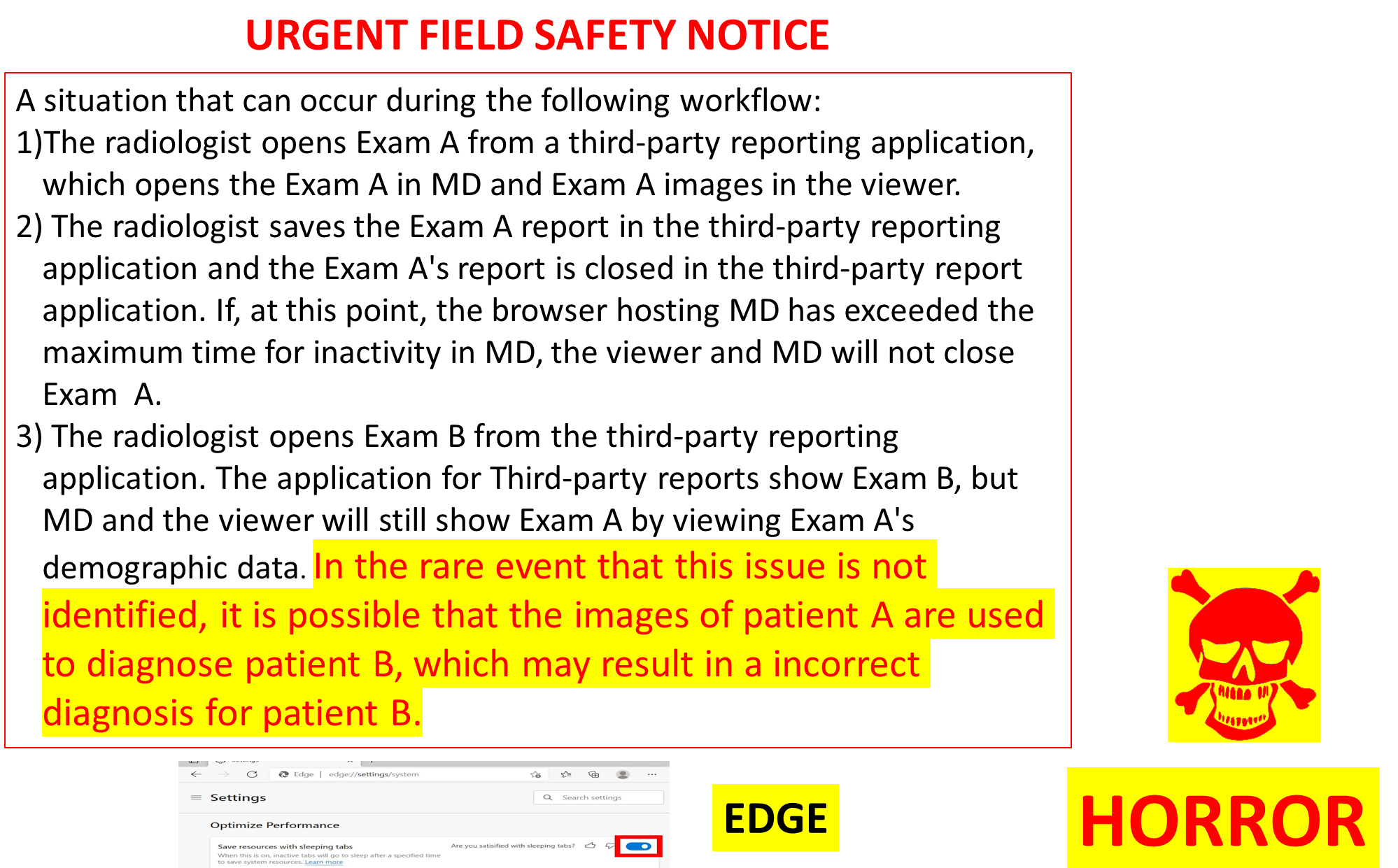Browser vs Medical Device

⚠️ WARNING - #browser vs #medicaldevice. The attached sequence is contained in an "URGENT FIELD SAFETY NOTICE" from one of the most well-known brands of medical devices. Demonstrates how it is necessary to use browsers with medical devices with caution. It also denotes a lack of understanding of browsers as well as important gaps in risk analysis. Browsers do not have the slightest "awareness" of what they are viewing and how important what they view is because browsers "ARE NOT DESIGNED TO BE USED IN MEDICAL DEVICES"! Indeed, in reality it is much worse, in the Microsoft contract we read:
DISCLAIMER OF WARRANTY. THE SOFTWARE IS LICENSED “AS IS.” YOU BEAR THE RISK OF USING IT. MICROSOFT GIVES NO EXPRESS WARRANTIES, GUARANTEES, OR CONDITIONS. TO THE EXTENT PERMITTED UNDER APPLICABLE LAWS, MICROSOFT EXCLUDES ALL IMPLIED WARRANTIES, INCLUDING MERCHANTABILITY, FITNESS FOR A PARTICULAR PURPOSE, AND NON-INFRINGEMENT.
Recently Microsoft added a feature to its browsers that is very convenient for a home user, but fatal for a medical device. After a certain period of inactivity it "freezes" the tabs so that they do not continue to consume resources (since many sites auto-refresh even if no one is looking at them!). In some conditions when a medical device uses a browser it finds itself displaying "frozen" information and not the newest information. Precisely because for a browser a URL is nothing more than a URL and if the browser rightly (or wrongly) believes that it has already viewed the content, there is nothing the manufacturer of the medical device can do. In general, no one has control over what a browser will show to the user. because the browser is not made to be in a medical device but is a consumer product: much worse, the manufacturer cannot even know what the browser has done afterwards . This situation is made worse by the fact that browsers frequently update, introducing crazy, out-of-control features that undermine the security of medical devices. Are there solutions? Yes, but they do not always exist and are complex, both at a design and regulatory level. Be extremely careful when using browsers and use them only after careful planning: let yourself be guided by experts in the risk sector! It is not enough to be a computer scientist, you need to have high IT skills combined with high-level risk analysis skills. The browser is a difficult beast to tame, it's not a job for everyone. You could cause serious harm to the patient!
⚠️ WARNING - #browser vs #medicaldevice. La sequenza allegata è contenuta in un "URGENT FIELD SAFETY NOTICE" di una delle più note marche di dispositivi medici. Dimostra come sia necessario usare i browser con i dispostivi medici con prudenza. Denota anche una carenza di comprensione dei browser anche lacune importanti nell’analisi dei rischi. I browser non hanno la minima "coscienza" di cosa stanno visualizzando e di quanto sia importante ciò che visualizzano perché i browser "NON SONO PROGETTATI PER ESSERE UTILIZZATI IN DISPOSITVI MEDICI" ! Anzi , in realtà è molto peggio, nel contratto Microsoft si legge :
DISCLAIMER OF WARRANTY. THE SOFTWARE IS LICENSED “AS IS.” YOU BEAR THE RISK OF USING IT. MICROSOFT GIVES NO EXPRESS WARRANTIES, GUARANTEES, OR CONDITIONS. TO THE EXTENT PERMITTED UNDER APPLICABLE LAWS, MICROSOFT EXCLUDES ALL IMPLIED WARRANTIES, INCLUDING MERCHANTABILITY, FITNESS FOR A PARTICULAR PURPOSE, AND NON-INFRINGEMENT.
Recentemente Microsoft ha aggiunto una feature ai suoi browser molto comoda per un utente domestico, ma fatale per un dispositivo medico. Dopo un certo periodo di inattività "congela" i tab in modo che non continuino a consumare risorse (visto che molti siti fanno l'auto-refresh anche se nessuno li guarda!). In alcune condizioni quando un dispositivo medico usa un browser si ritrova a visualizzare le informazioni "congelate" e non quelle più nuove. Proprio perché per un browser una URL non è nient'altro che una URL e se il browser ritiene, a torno a ragione di aver già visualizzato il contenuto, non c’è niente che il costruttore del dispositivo medico possa fare. In generale nessuno ha il controllo su cosa mostrerà un browser all'utente perché il browser non è fatto per stare in un medical device ma è un prodotto consumer: anzi molto peggio, il fabbricante non può neanche saper ciò che il browser ha fatto a posteriori. Questa situazione è aggravata dal fatto che i browser si aggiornano di frequente introducendo caratteristiche folli, fuori controllo, che miniano la sicurezza dei dispostivi medici. Esistono soluzioni ? Sì, ma non esistono sempre e sono complesse, sia a livello progettuale che a livello regolatorio. Fate estrema attenzione ad usare i browser e usateli solo dopo un'attenta progettazione : fatevi guidare da esperti del settore dei rischi ! Non basta essere informatici, occorre avere un'alta competenza di informatica unita ad una competenza di alto livello sull'analisi dei rischi. Il browser è una bestia difficile da domare, non è un lavoro per tutti . Potreste fare gravi danni al paziente !

Comments ()